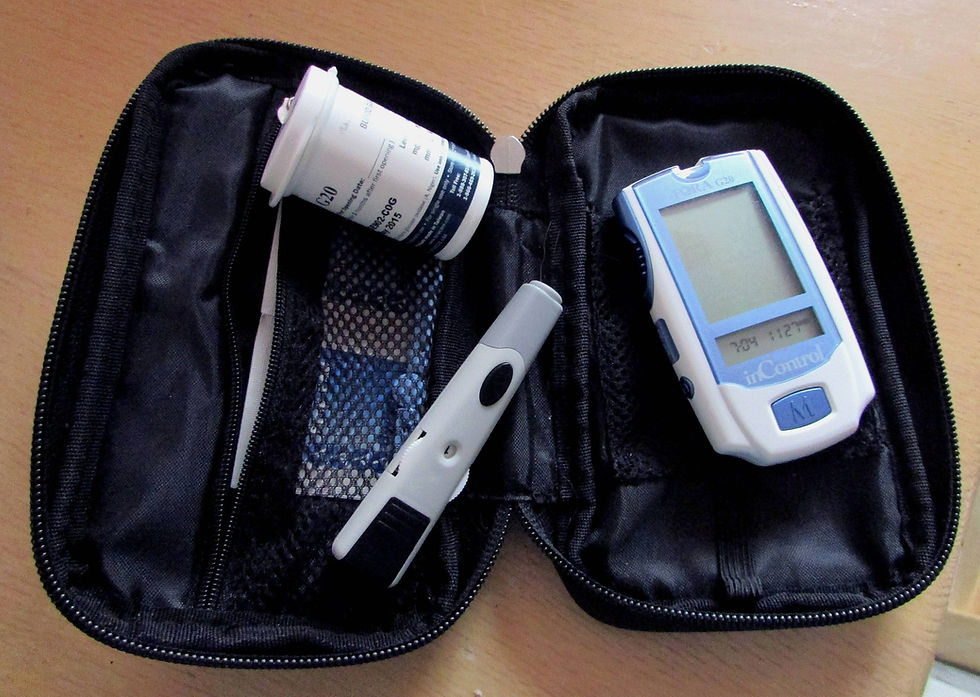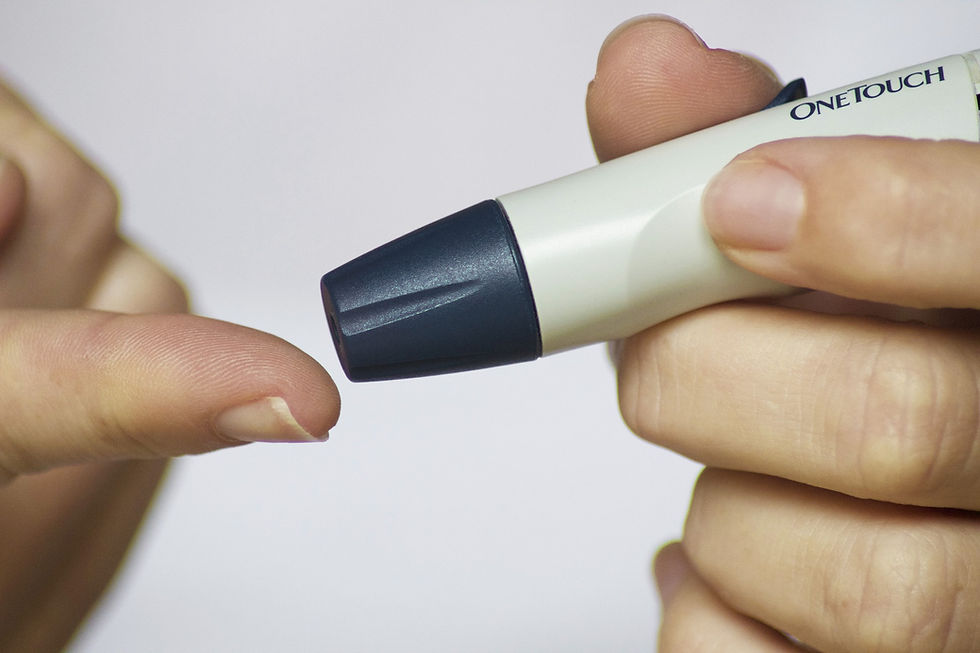Type 1 Diabetes Mellitus
- The Aspiring Medics

- Jun 29, 2020
- 7 min read
Updated: Sep 8, 2020
In this series of articles, medical students from across the country will share their knowledge of medical physiology, anatomy and biochemistry to give you a taster of medical school. This will be a fantastic opportunity to build upon your A-Level Knowledge.
Remember it's more important to understand the principles than to mindlessly memorise facts.
Diabetes is an extremely common condition in Western countries, and there are 2 main prevalent forms - Type 1 and Type 2. In this article we will look at what Type 1 diabetes is, why it occurs, how this relates to its symptoms and finally how it is managed. Type 1 diabetes mellitus (T1DM) is a disorder of the metabolism resulting in high blood sugar concentration (hyperglycaemia) as a result of insulin deficiency.

🔬Causes and Physiology
Type 1 diabetes is a disease of insulin deficiency. There are 3 reasons this deficiency can occur:
Immune mediated - The immune system mistakenly attacks and destroys the insulin producing beta-cells in the pancreas. There is no one cause of this autoimmune response, rather a complex interplay of genetic and environmental factors. Without any cells to produce it, insulin cannot be released when required. Interestingly the other cells in the Islets of Langerhans (where the beta-cells are found) are not damaged.
Secondary to other diseases - Type 1 diabetes can also develop as a result of (secondary to) other diseases or conditions including pancreatitis and pancreatic trauma
Idiopathic - In medicine the term idiopathic is used to refer to something that occurs without a known cause. In these cases, the pancreas stops producing insulin but no pathological process is detected to cause it.

The immune based nature of this disease means that many patients first notice this as children or young adults. As we mentioned in the article on glucose control (if you haven't looked at it we'd recommend giving it a read and then coming back!), the role of insulin in the body is to reduce blood sugar concentration when it starts to rise too high. If the pancreas isn't producing insulin, blood glucose will continue to rise in the blood unchecked and this can cause 3 of the key symptoms of diabetes. Namely these are:
Polydipsia - feeling very thirsty and wanting to drink a lot of water
Polyuria - urinating more frequently
Polyphagia - wanting to eat more
The reason these symptoms appear is relatively clear when we look at the physiology. Wherever we have glucose, the body likes there to be a balance between glucose and water. When we have too much glucose, our body tries to restore this balance by increasing our water intake leading to polydipsia.
At the same time, the kidneys cannot reabsorb all the sugar in the blood as it is filtered through them, and so excess glucose ends up in the urine. Once again, in an effort to maintain the a balance between glucose and water, water follows this excess glucose into the urine. This means that we form a greater volume of urine and experience polyuria.
The cells around the body continue to need glucose to work, however the lack of insulin signalling means that these cells cannot take in any more glucose. The body's natural response to this is to take in more glucose which results in polyphagia.
🩸Testing

There are 2 ways that testing for diabetes can be done - at the bedside or in the form of blood tests that get sent to a lab for analysis.
Bedside Testing:
Urine dipstick (ketostix) testing - this test identifies the presence of both glucose and ketones in the urine.*
Blood sugar testing - a random blood glucose test can tell you if a patient’s blood sugar is running high enough to raise suspicion of diabetes. Some of these tests can also check for the presence of ketones*.
Lab Testing:
Fasting blood glucose - the blood glucose level of a patient is tested after they have fasted for 8 hours.
Oral Glucose Tolerance Testing (OGTT) - following the fasting blood glucose above, the patient is given a drink containing 75g of glucose. Their blood glucose is then tested again 2 hours after this to measure their response to the glucose and how much of it is left in the blood (as opposed to being transported into the cells courtesy of insulin).
NB - There are guidelines allowing diagnosis of diabetes from either the fasting glucose test, the OGTT, or both.
HbA1c - When there is a consistently raised glucose level in the blood, some of it will bind to haemoglobin which is what HbA1c measures. It gives an indication of what the blood sugar levels have been like in the 3 months prior to the reading being taken. It’s typically used for monitoring patients that have already been diagnosed with glucose. However it’s being used more often now in screening as it doesn’t require fasting. This being said there are some situations where it cannot be used. HbA1c cannot be used to confirm a diagnosis if the patient:
Has Type 1 Diabetes
Has symptoms that only came on within the last 2 months
Is a child
Is pregnant
💉Treatment
For Type 1 diabetics they all begin on what is called a basal-bolus insulin regimen. This consists of 2 parts:
Basal insulin - Taking a long acting, slow release insulin once or twice a day to maintain a steady level of blood insulin throughout the day
Bolus insulin - Taking a rapid acting, quick release insulin at meal times to counteract the spike in blood glucose that comes with eating.

However, this is only one side of the treatment. Newly diagnosed Type 1 Diabetics also need to have a structured education regarding the amount of carbohydrates in different meals, allowing them to alter their bolus dose of insulin proportionally. One example of a programme available on a national level that provides such education is called DAFNE - Dose Adjustment for Normal Eating.
In general, it’s suggested that complex carbohydrates consumption (pasta, rice, potatoes) is moderated as they result in rapid glucose spikes. Carbohydrates that result in a slower release of glucose into the blood those with a low glycemic index (GI), are preferred in order to make keeping blood glucose levels at normal levels more manageable.
📊Monitoring

Monitoring of blood glucose at home is vital for Type 1 Diabetics. There are 3 ways that this can be done:
Finger prick testing with a diary - Patients are given a blood glucose monitor that works by testing the glucose level in a small drop of blood. The readings from this are then recorded in a diary that allows healthcare professionals check them at appointments. Patients may need to take these readings 8 or more times every day, needing to prick a new area each time.
Flash glucose monitoring - A small sensor placed under the skin can be scanned by a device and give a glucose reading such as the Freestyle Libra device. This sensor measures glucose levels in the fluid that surrounds the cells as opposed to directly in the blood. As a result, it has a bit of a lag behind what blood glucose testing would show. Therefore, if patients feel as though their condition is acutely deteriorating, they must use finger prick testing.
Continuous glucose monitoring - Similar to flash glucose monitoring, a small sensor is placed under the skin to measure glucose in the fluid surrounding the cells. The difference, however, is that this device monitors glucose levels continuously to give trends in the levels and can send alerts to a device if it is too high or low. It can be used as a standalone device or with an insulin pump (a device that can administer insulin directly into the blood at variable rates).
Although both flash and continuous glucose monitoring have been mentioned, patients must meet very strict criteria to be able to use either of these on the NHS. The criteria include (but are not limited to), a patient with:
Type 1 Diabetes needing to check blood more than 8 time per day
Type 1 Diabetes, has paid for Flash monitoring themselves in the past and has evidence that it improved their HbA1c
Type 1 Diabetes and has severe hypoglycaemic episodes or have reduced hypoglycaemia awareness
Type 1 Diabetes and is unable to test regularly due to a disability
Type 1 diabetes and pregnant
Appendix
*Regarding ketones:
The body has many ways to produce energy. The key one that you will all know about from GCSE and A-Level is aerobic respiration using glucose. You may also know that fat stores in the body serve many purposes in the body, one of which is as a store of energy. When the body uses these fat stores to make energy, it results in the production of molecules called ketones (the same ones you may have heard about in Chemistry!). Your body knows that when it has low levels of insulin, it’s because there’s a small amount of glucose available. It’s in these situations it will start to utilise fat to produce energy. This is why it’s really important to check ketone levels (either in blood or urine) of patients with diabetes - if they have high levels of ketones it tells you that it is an urgent situation and their body is starting to use fallback mechanisms to produce energy.
Key Words:
Type 1 Diabetes Mellitus - A condition where the body has an inability to respond to a rise in blood sugar concentration, typically following immune destruction of insulin producing pancreas cells.
Insulin - The hormone released in response to raised blood glucose concentration that stimulates body cells to absorb glucose from the blood.
Polyuria - A common symptom of diabetes involving frequent urination.
Polydipsia - Feeling more thirsty than normal and drinking more water through the day.
Polyphagia - Needing to eat more throughout the day
💭 Further Reading
Medical Disclaimer: The Aspiring Medics does not provide medical advice. The Aspiring Medics and the content available on The Aspiring Medis' properties (Aspiringmedics.co.uk and other channels) do not provide a diagnosis or other recommendation for treatment and are not a substitute for the professional judgment of a healthcare professional in diagnosis and treatment of any person or animal. The determination of the need for medical services and the types of healthcare to be provided to a patient are decisions that should be made only by a physician or other licensed health care provider. Always seek the advice of a physician or other qualified healthcare provider with any questions you have regarding a medical condition.


